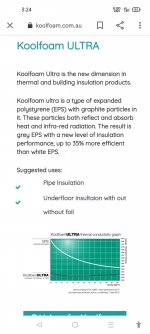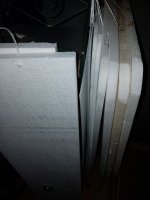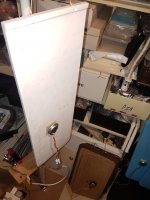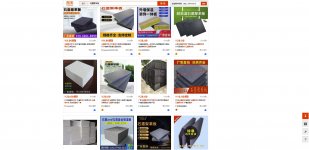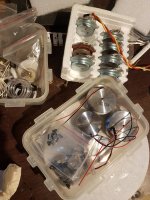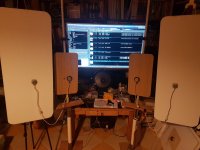I'm think it of all those poor campers ,who have parked in a nice quite field hoping for a nice quiet rest.Now sitting in our motorhome in a field in Queensland listening to Beth Nielsen Chapman over some very ordinary flush mount speakers thinking..that whole roof section could be DML speakers....hmm😜🤭🤫
only to find they have joined one of leobs festivals 😱😂🎻🎤🎸🎷🎺👍✌
Hello Danb11Jumping slightly off topic, but I'm wanting to make some translucent panels out of frosted acrylic/perspex. For aesthetic reasons. Can anybody suggest thickness and dimensions to try?
Notice bracing being used for the exciter. Why is this? Are they not designed to be self supporting?
I can't help you about those materials I haven't tested.
About the bracing, I would list 2 functions:
- for exciters with a simple front spider, it keeps the voice coil axis perpendicular to the panel, avoiding the effect of external forces like the weight of the cables. It exists also exciters with a double suspension (not tested)
- it limits the displacement of the exciter at low frequency avoiding to exceed the maximal stroke. This has a direct effect on the distortion at "low" frequency.
Last edited:
It is graphite enhanced EPS, but cannot figure out the density from the info on the page. It says 1.13 kg/me, but not at what thickness. The one I use is 25 kg/m3.Leob.
I noticed this product on line, I believe it is similar to what you are using.
It is in a size I have used before and am interested in using again.
for 7 panels it is only about £22 but for 8 it works out at about £48 both with delivery?
If you think this is the same as your eps panels ,I might give them a call and confirm the prices .
Steve.
https://ewistore.co.uk/shop/external-wall-insulation/eps-insulation-1-board-0-72m2/
Seems worth a try for sure if one can order thin plates in low quantity.
Should be no overtones when playing a sine. I did play sines quite a bit when diagnosing the heat sag issue I mentioned earlier. I also done some spectral multitone analysis on a few panels as well as played many sine sweeps.Eric.
I did as you said and lowered the volume and watched the higher tone reduce with the lower tone until the higher tone disappeared below my screen ?
By then I could hardly hear the lower tone.
But obviously the higher tone is still there, it has just moved off screen.
My question is what happens when we play music much louder than this with similar sounds or tones ? Will the higher tone still be there ?
Or is it something we just have to live with.
Steve.
I find that harmonic distortion is very low in DML panels in general. Apart from the heat sag I had issues with mounting causing distortion sometimes, but most of the time they performed much better than my regular monitors when looking at harmonic distortion in REW.
I think DML can cause some kind of phase distortion, but loud harmonic distortion is an indication your source, amp, exciter or plate and mounting is defect somehow.
Leob.
I did not say the harmonic distortion was loud ,I could just see, not hear , a small peak at double the frequency but only below 500hz.
I was just asking if anyone had measured this or new what was causing it.
I was more interested in the increase in low frequency resonance from 50hz to 100hz when bracing the edges as shown in the plots.
Steve
I did not say the harmonic distortion was loud ,I could just see, not hear , a small peak at double the frequency but only below 500hz.
I was just asking if anyone had measured this or new what was causing it.
I was more interested in the increase in low frequency resonance from 50hz to 100hz when bracing the edges as shown in the plots.
Steve
First of all congatulations for your 'festival'/large venue achievement using DML panels. Wish I was there...It is graphite enhanced EPS, but cannot figure out the density from the info on the page. It says 1.13 kg/me, but not at what thickness. The one I use is 25 kg/m3.
Seems worth a try for sure if one can order thin plates in low quantity.
I find it hard to source graphite enhanced EPS Neopor (GPS) materials in Australia. The closest material is XPS - available in 30mm thickness with a density of ~ 32 kg/m3.
Hi SonnarFirst of all congatulations for your 'festival'/large venue achievement using DML panels. Wish I was there...
I find it hard to source graphite enhanced EPS Neopor (GPS) materials in Australia. The closest material is XPS - available in 30mm thickness with a density of ~ 32 kg/m3.
Here 'tis
Brisbane based...supposedly available in any thickness
Eucy
Attachments
Thank you. I will call them tomorrow!Hi Sonnar
Here 'tis
Brisbane based...supposedly available in any thickness
Eucy
Sonnar...Have you considered the XPS sheets sold by Bunnings..$15 per sheetThank you. I will call them tomorrow!
Worth a try as a comparison at least
If you can see additional peaks when playing a sine you have harmonic distortion. My point was that I have not seen that in my measurements except when having the issues I mentioned.Leob.
I did not say the harmonic distortion was loud ,I could just see, not hear , a small peak at double the frequency but only below 500hz.
I was just asking if anyone had measured this or new what was causing it.
I was more interested in the increase in low frequency resonance from 50hz to 100hz when bracing the edges as shown in the plots.
Steve
Thanks! The difference between graphite enhanced EPS and regular is not that great. I found that the Neopor sounded a bit tighter than the regular EPS I had, but it might be a bigger difference between regular EPS of different makes and density than between graphite EPS and regular. I don't have enough experience to tell really. So it is probably worth looking for GPS, but I think any EPS you can find in thin sheets (20-25mm seems good) and reasonable density (20-25 kg/m3) without buying bulk would be worth a try.First of all congatulations for your 'festival'/large venue achievement using DML panels. Wish I was there...
I find it hard to source graphite enhanced EPS Neopor (GPS) materials in Australia. The closest material is XPS - available in 30mm thickness with a density of ~ 32 kg/m3.
I bought and tried eps from 11 to 18k, they all have sound different. (heavier better)Thanks! The difference between graphite enhanced EPS and regular is not that great. I found that the Neopor sounded a bit tighter than the regular EPS I had, but it might be a bigger difference between regular EPS of different makes and density than between graphite EPS and regular. I don't have enough experience to tell really. So it is probably worth looking for GPS, but I think any EPS you can find in thin sheets (20-25mm seems good) and reasonable density (20-25 kg/m3) without buying bulk would be worth a try.
The heavier I can purchase here they "marked" 25k but actually just around 18kg/m3.
The best one is an air-conditioner packing board I pick which at 41kg/m3 (pic2). It sounds so GREAT but there're no way to get this in a bigger side. It's original size is 59x38x1cm. I have to cut it in two to be L and R. Fortunately the sound signiture image size don't change just loss some low end. Smaller size also make the sound stage a little deeper. It's my default panel now.
I also want to try the graphite one but they're all comes with 5cm thick.
Tried seveal thickness of xps too but all sounds like toy even apply a "deep" sanding to remove the skin totally. Give up.
Attachments
Leob.
In the UK ,b&a sell jablite grey for £43 for 8 panels 25mm x1200x450mm ,the white is a few pounds cheaper .
Or I can get the grey panels from ewistore for £22 for a 20mm 1200x600mm panel.
It would be nice to compare the white with the grey but that would double the price 😬
I managed to have a feel , and scratch tested the jablite white and grey, in store, and I thought they felt and sounded slightly different..
As you are unsure of the difference in sound , I am having second thoughts , as I already have many white samples.
And am about ready to get back to testing EPS panels again.
Steve.
In the UK ,b&a sell jablite grey for £43 for 8 panels 25mm x1200x450mm ,the white is a few pounds cheaper .
Or I can get the grey panels from ewistore for £22 for a 20mm 1200x600mm panel.
It would be nice to compare the white with the grey but that would double the price 😬
I managed to have a feel , and scratch tested the jablite white and grey, in store, and I thought they felt and sounded slightly different..
As you are unsure of the difference in sound , I am having second thoughts , as I already have many white samples.
And am about ready to get back to testing EPS panels again.
Steve.
Hkguy6.
OH dear, someone's room looks similar to mine, nice collection of panels.
Personally I'm not sure that the heavier EPS panels do sound better than the lighter EPS ?
I was getting some very good sounds from some low grade 1cm EPS packing material with a coating of 50x50 pva.
But which ever, EPS is my favourite.
Steve.
OH dear, someone's room looks similar to mine, nice collection of panels.
Personally I'm not sure that the heavier EPS panels do sound better than the lighter EPS ?
I was getting some very good sounds from some low grade 1cm EPS packing material with a coating of 50x50 pva.
But which ever, EPS is my favourite.
Steve.
Sound Better is just represent my peronal perference. Not measurement wise.Hkguy6.
OH dear, someone's room looks similar to mine, nice collection of panels.
Personally I'm not sure that the heavier EPS panels do sound better than the lighter EPS ?
I was getting some very good sounds from some low grade 1cm EPS packing material with a coating of 50x50 pva.
But which ever, EPS is my favourite.
Steve.
Other corner and stuffs.
The last pic is my peronal best sound settings up to now. But not for daily listen because space. 🙁
Attachments
To clarify, there is a clear difference in sound with the GPS and.EPS plates I tried, but that is true for the different EPS I tried as well. The EPS with similar density was the.seconds best, so I think the added graphite does matter and creates a slightly more dampened plate, resulting in a more defined sound. It is like the plain EPS has a very nice chorus effect, which sounds glorious on some material, but the GPS give a more accurate reproduction.Leob.
In the UK ,b&a sell jablite grey for £43 for 8 panels 25mm x1200x450mm ,the white is a few pounds cheaper .
Or I can get the grey panels from ewistore for £22 for a 20mm 1200x600mm panel.
It would be nice to compare the white with the grey but that would double the price 😬
I managed to have a feel , and scratch tested the jablite white and grey, in store, and I thought they felt and sounded slightly different..
As you are unsure of the difference in sound , I am having second thoughts , as I already have many white samples.
And am about ready to get back to testing EPS panels again.
Steve.
Since you like unsuspended plates, it might be the case that you actually prefer the sound of plain EPS.
Cripes, that is my room 🤣Sound Better is just represent my peronal perference. Not measurement wise.
Other corner and stuffs.
The last pic is my peronal best sound settings up to now. But not for daily listen because space. 🙁
Uh....yeah, kinda.Thank you eucy, harmonics, that was the word I was trying to remember, I was having a senior moment😲 I new the word this morning 😀
all instruments have them and I suppose panels are no different ?
Steve.
Yes, for sure, DML panels have "natural frequencies" also called "resonances frequencies" or "eigenfrequencies". In fact, those natural frequencies are the "modes" from which a Distributed Mode Loudspeaker gets it's name.
But the interesting thing about panels is that their resonance frequencies are almost never "harmonics". Harmonics are natural frequencies that are integer multiples of each other, like 100 Hz, 200 Hz, 300 Hz, etc. Indeed, tensioned strings (like on a piano) and pipes (like flutes) have a series of natural frequencies that are integer multiples of each other, and hence have "harmonics". Panels, on the other hand, exhibit a set of natural frequencies which are very irregularly spaced along the frequency spectrum, and decidedly non-harmonic (not integer multiples).
So if a panel plays harmonics when fed a pure sinusoidal tone, I think it's more accurate to say that it is "despite" being a panel, rather than "because" it's a panel.
I do wonder how many of us comprehend this simple fact: the primary effect that virtually every design factor we ever discuss in this thread is that it influences the set of natural frequencies of our panel.
Panel stiffness, density, anisotropy, thickness, size, aspect ratio, stiffeners, added masses: The main impact (by far) of modifying any of these features is to influence the distribution of the panel's natural frequencies along the frequency spectrum.
Likewise, the type of suspension chosen: free, hinged around the perimeter, clamped around the perimeter, or whatever. The main impact of the suspension mode is to determine the distribution of the panels natural frequencies along the frequency spectrum. Yes, sure, the suspension has a big impact on damping, which has important influences, but first and foremost, suspension determines the distribution of the natural frequencies.
Exciter placement too. For light panels, the exciter placement influences the distribution of natural frequencies. And for all panels (heavy or light), exciter placement determines which of these natural frequencies will be emphasized, and which will be deemphasized.
In other words, to design a DML is essentially to select (either by accident or on purpose) a set of natural frequencies than can be coerced into producing a reasonably flat frequency response over some particular frequency range.
Eric
- Home
- Loudspeakers
- Full Range
- A Study of DMLs as a Full Range Speaker
